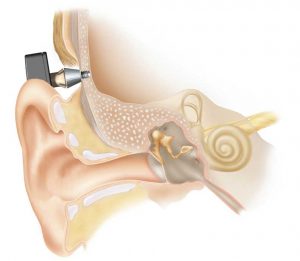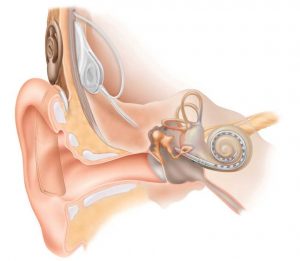 What is a bone anchored hearing aid?
What is a bone anchored hearing aid?
A bone anchored hearing aid is a small complex implantable hearing device. The official name is an osseointegrated temporal bone implant. This device is used for certain kinds of hearing losses to help children or adults hear sounds and speech better. The implant consists of a titanium screw that is implanted into the bone behind the ear under the skin and either an abutment or magnet that is attached directly to the implant screw. There is an external part called a processor that attaches either to the abutment or the magnet behind the ear. The processor has these parts:
- A microphone, which picks up sound from the environment.
- A speech processor, which selects and arranges sounds picked up by the microphone.
- A transmitter and stimulator, which receives signals from the speech processor and converts them into mechanical impulses.
Who gets osseointegrated implants?
Children and adults with hearing loss may be fitted with this type of device. For children less than 5 years of age, a softband can be worn for one – sided deafness or another type of hearing loss – called a conductive hearing loss – for example those born without an external ear, eardrum or the middle ear bones. Adults may benefit from this technology if they have had previous surgery in their ears, or have loss of the conductive bones or eardrum, or ear canals that will not properly accept or hold a hearing aid. Adults with one – sided deafness can also benefit from this implant, just as children do.
How does someone receive an osseointegrated implant?
A hearing test will be performed in our audiology office and the results will be reviewed by both the audiologist and your physician. Your hearing healthcare team can tell by the results of your testing if this type of implant would help with your hearing loss. A brief trial using a demonstration model of the implant can be easily and quickly done in the office to determine if your hearing loss can be overcome with the use of this type of implant. The implant will require a brief outpatient surgical procedure to place it behind the affected ear. The surgical procedure for placing the implant will be discussed with you, and if appropriate, will then be scheduled. Surgical implantations are safe and have relatively few complications, but should always be discussed with your implant surgeon.
 What is a cochlear implant?
What is a cochlear implant?
A cochlear implant is a small, complex electronic device that can help to provide a sense of sound to a person who is profoundly deaf or severely hard-of-hearing. The implant consists of an external portion that sits behind the ear and a second portion that is surgically placed under the skin (see video). An implant has the following parts:
- A microphone, which picks up sound from the environment.
- A speech processor, which selects and arranges sounds picked up by the microphone.
- A transmitter and receiver/stimulator, which receive signals from the speech processor and convert them into electric impulses.
- An electrode array, which is a group of electrodes that collects the impulses from the stimulator and sends them to different regions of the auditory nerve.
An implant does not restore normal hearing. Instead, it can give a deaf person a useful representation of sounds in the environment and help him or her to understand speech.
How does a cochlear implant work?
A cochlear implant is very different from a hearing aid. Hearing aids utilize a sound processing technology to help sounds to be detected by damaged hearing nerves. Cochlear implants bypass damaged portions of the inner ear and directly stimulate the auditory nerve. Signals generated by the implant are sent by way of the auditory nerve to the brain, which recognizes the signals as sound. Hearing through a cochlear implant is different from normal hearing and takes time to learn or relearn. However, it allows many people to recognize warning signals, understand other sounds in the environment, and understand speech in person or over the telephone.
Who gets cochlear implants?
Children and adults who are deaf or severely hard-of-hearing can be fitted for cochlear implants. The FDA first approved cochlear implants in the mid-1980s to treat hearing loss in adults. Since 2000, cochlear implants have been FDA-approved for use in eligible children beginning at 12 months of age. For young children who are deaf or severely hard-of-hearing, using a cochlear implant while they are young exposes them to sounds during an optimal period to develop speech and language skills. Research has shown that when these children receive a cochlear implant followed by intensive therapy before they are 18 months old, they are better able to hear, comprehend sound and music, and speak than their peers who receive implants when they are older. Studies have also shown that eligible children who receive a cochlear implant before 18 months of age develop language skills at a rate comparable to children with normal hearing, and many succeed in mainstream classrooms.
Many adults who have lost all or most of their hearing later in life can also benefit from cochlear implants. They learn to associate the signals from the implant with sounds they remember, including speech, without requiring any visual cues such as those provided by reading lips or sign language.
How does someone receive a cochlear implant?
If hearing aids are no longer of benefit, a special hearing evaluation called a “ Cochlear Implant Evaluation” is performed in our audiology offices to determine if a person is a good candidate for an implant. Before and/or after this evaluation the implant surgeon reviews the implant process with the patient and family. Use of a cochlear implant requires both a surgical procedure and significant therapy to learn or relearn the sense of hearing. Not everyone performs at the same level with this device. The process can be expensive. For example, Medicare, or a person’s private health insurance may cover the expense, but not always. Some individuals may choose not to have a cochlear implant for a variety of personal reasons. Surgical implantations are almost always safe, although complications are a risk factor, just as with any kind of surgery. Another consideration is learning to interpret the sounds created by an implant, because this process takes time and practice. Our audiologists are involved in this learning process, using the latest technology to help map out the best stimulation strategy for each patients inner ear nerve and hearing result.
